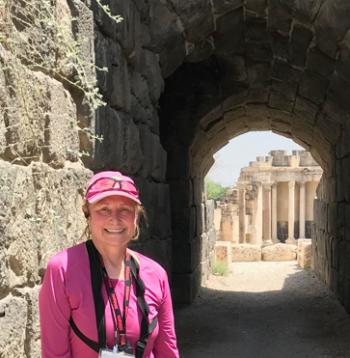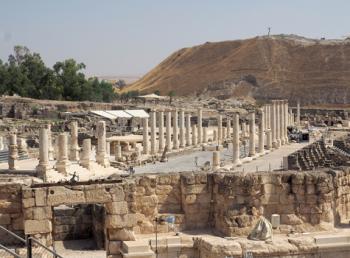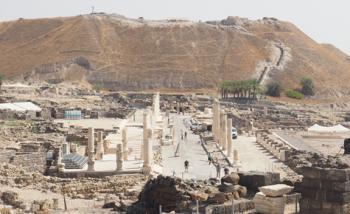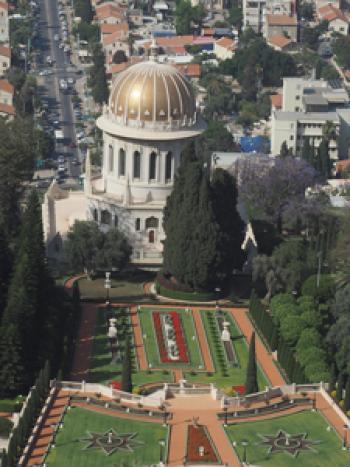Israel — Archaeology 101
This item appears on page 25 of the November 2018 issue.
In the fall of 2016, I realized I wanted to visit Israel after seeing a Jerusalem exhibit at the Metropolitan Museum of Art in New York. I had previously traveled on a trip for which the Archaeological Institute of America (Boston, MA; 857/305-9350, www.archaeological.org) had been a cosponsor, so I found their site.
Their trip "Israel: Treasures of the Holy Land," which took place May 11-22, 2017, was everything I wanted — a small group (14 people) accompanied by a senior archaeologist and with a "dig" in Israel. Not including international airfare, the cost of the trip was $8,995 plus $3,245 as a single.
The hotels we stayed in were all 5-star. Breakfasts and dinners were included. We usually ate lunch together.
I wasn't disappointed with the tour. In fact, it was as if I were taking a college archaeology course with an excellent professor.
Our first morning, we were off to Caesarea Maritima, where we settled into a routine for each site we visited. Jodi Magness of the University of North Carolina, leader of the dig at Huqoq, would sit us in the shade and explain the history and significance of the site. Caesarea was a major seaport built by Herod the Great in the 1st century BC.
We headed to Haifa and our next hotel, first stopping at the magnificent Bahá'í Gardens.
In the morning, we drove to Tel Megiddo, an archaeological settlement mound at a location thought to be where Armageddon will happen. Again, we spent about 45 minutes discussing the site. There are at least 25 layers of habitation there, dating from between 4000 and 450 BC. We also visited the necropolis in the ancient town of Beit She'arim.
We left for Galilee the next day, first visiting Sepphoris (aka Zippori, one of the capitals of Galilee during the 1st century), where we saw spectacular mosaics, and the Nile House, with Egyptian-style mosaics, including a nilometer. From atop the Crusader fortress, we could see Nazareth. We walked our first cardo, an ancient Roman street once with shops along the sides.
At the Sea of Galilee, we saw the 2,000-year-old Ancient Galilee Boat, found in 1986. Jodi surprised us by introducing us to the woman who had headed that excavation.
The next two days were spent in Roman, early Jewish and Christian sites in Galilee.
In Tabgha, there is a church that commemorates the multiplication of loaves and fish. Capernaum was the center of Jesus' ministry, with a huge ancient synagogue and an octagonal church built over the site of Peter's house. Hamat Tiberias National Park has the remains of a 4th-century synagogue with a magnificent mosaic floor.
Beit She'arim was an extensive Roman city on a hill, with a full bathhouse, multiple cardos (the cardos there and at Sepphoris were magnificent), mosaics and an amphitheater. Beit Alfa was another old synagogue with a wonderful mosaic floor. Everyplace we went, we first learned its history, which made the entire experience special.
We drove along the Jordan River and began the ascent to Jerusalem. Late in the afternoon, we drove through Jerusalem to an overlook for a panoramic view. We checked into our hotel (the Waldorf Astoria Jerusalem) for six nights.
Jerusalem was not at all what I expected, even after my visits to the Met. In the Old City, we visited the various sections: Armenian, Muslim, Jewish and Christian. Although it stands outside the walls, the City of David site was the original urban center of Jerusalem and interesting to visit, including walking down to the original water tunnel.
One morning we visited the Albright Institute of Archaeological Research (www.aiar.org), one of the oldest archaeological research organizations. We walked through the Damascus Gate and along the main cardo to the Via Dolorosa, visiting a Catholic monastery along the way.
We passed Stations of the Cross and walked along the covered cardo until we reached the Church of the Holy Sepulchre. There we saw Golgotha (where Jesus was crucified) and the tomb where it is believed he was buried and resurrected. On another morning, we walked through the passageway along the Western Wall below Wilson's Arch.
The last morning, we visited the Jewish Quarter that was rebuilt after the unification of Jerusalem. The Wohl Museum of Archeology consists of the excavated 2,000-year-old homes of the priestly caste and others. The area actually overlooks the Temple Mount.
On other days, we visited Masada, floated in the Dead Sea and visited Qumran, where the Dead Sea Scrolls were found. In the Israel Museum, we met with conservators who were working on the scrolls. We saw the technology being used to preserve them and to enhance the reading of them.
A visit to Bethlehem, without our guides, took us to the Church of the Nativity. Bethlehem was special but touristy.
In Israel, and in Jerusalem in particular, I saw tourists and pilgrims from all over the world enjoying themselves. I was surprised by how many there were!
Anyone with questions about this tour can email me at marilynarmel180@gmail.com.
MARILYN ARMEL
New York, NY




